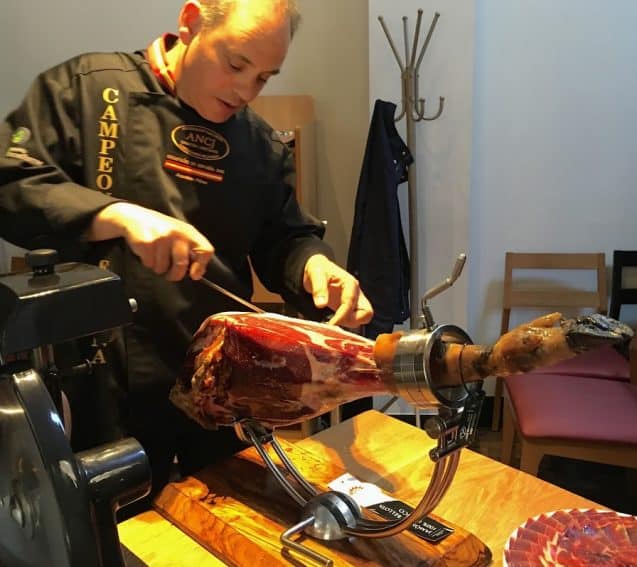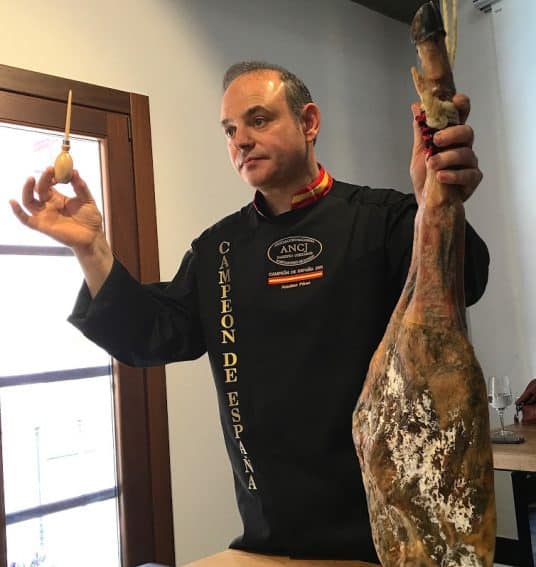
In Spain You Can Learn to Cut Iberian ham from a Spanish champion
By Jackie Sheckler Finch
Anselmo Perez didn’t eat much Iberian ham when he was growing up. “We couldn’t afford it,” he said.

Now, Perez can eat as much of the exquisite delicacy as he wants. And he can have it carved by one of Spain’s champion Iberian ham carvers – himself.
“I eat it every day,” he said. “Iberian ham is good for you.”
And it is important that he samples the ham being served at the restaurant he opened two years. Named Corte & Cata, the popular dining spot is in the historic center of Perez’s hometown, Salamanca, Spain.
“The name means ‘Cut and Taste’ because that’s what we do here,” Perez said.
Along with being a popular restaurant, Corte & Cata has a large upstairs room where Perez gives lessons in ham carving and tasting. The classes are popular with travelers and international groups who learn that how a ham is cut can enhance or harm its flavor.
“Cutting a ham is an art that takes years of practice and experience,” Perez said. “Cutting a ham correctly can turn a mere tasting of ham into something really extraordinary. The flavors and aromas of the ham are praised through the properly cut of the piece.”

First, Perez said, “Never use an electric knife, the friction of an electric knife can change the flavor of Iberian ham. It has to be cut by hand with a very sharp knife.”
The finer the slice, the finer the taste. Perez can cut ham so thin you can read the maker’s mark on the knife he is using.
So how did a man from a humble family learn the art of ham cutting and become the champion ham cutter of Spain for the year 201, a man who now travels around the world to demonstrate his skills?
“I taught myself,” he said. “I watched, I did it, and I learned. It is difficult because no one taught me the profession. I wanted to learn everything I needed on ham so I am totally self-taught.”
Learning the Hard Way

Growing up, Perez said, some of his friends had farms and raised pigs. “They had ham and if there was an event or party, I liked to cut the ham,” he said, adding that as a teen his “hobby” gave him many cuts on his hands and helped him develop his own unique style.
That style soon proved to be quite winning. Over the years, Perez has won many ham cutting awards, including the top one in 2011. “You can only be champion of Spain once,” he said, gesturing to the 2011 designation on his uniform jacket.
Now he shares his winning ways and ham knowledge to hopeful ham cutters and to folks like me who just want to eat it. Tastings can last 30 minutes or more; classes run two to three hours.
What does it take to be a winner? A steady hand, a quick but sure cut, a knowledge of which way to cut for the best taste, excellent equipment, an artistic way of arranging the slices, and a respect for the meat being cut.
“I am a quick cutter but you have to be more than fast,” he said, adding that most ham cutting competitions take two hours. “To finish the work first means nothing if the work is done wrong. A good cutter is one that cuts quickly and well … Nothing is wasted. When I am done, this bone will be clean.”
Standing very still when cutting is important both for the presentation and for safety. “Cutting is dangerous because the cutter can be cut.”
Arranging thin bite-sized slices of ham in an artistic display also is judged, Perez said. “Cutting good ham is an aesthetic experience. I seek to be creative and convey ham that looks good and tastes the best.”

Using All the Senses
Of course, if the ham that is being cut is not top quality, then it will not have the memorable Iberian taste no matter how well it is cut. As part of his classes, Perez uses a large

audiovisual presentation to show what makes an Iberian ham and how to identify a quality ham.
“Seventy percent of Iberian ham is from Salamanca,” Perez said. “The pig has a free life in the countryside and lives with other animals. The pig feeds on acorns and grass and water.”
An Iberico pig is big with slender legs and a very long snout. Iberico pigs are black with little hair and have black hooves as well. The black hoof remains on the ham throughout the curing and cutting process.
“There are different kinds of pigs but the top quality is the black pig,” Perez said. “The white pig is the worst quality.”
Selecting a great ham is not an easy task, Perez said and is often best left up to an expert. The important process involves all the senses. Sense of touch lets a buyer feel if the ham has been cured successfully. Sense of sight provides information about the proportion of fat which will affect the taste.
The sense of smell comes with the “cala” process. Perez showed how he uses a sharpened beef bone to insert it near the ham’s bone to check the aroma. The smell gives information about the curing process, the salt and the quality of the ham.

The sense of taste is the reward for choosing a good ham and having a skilled ham cutter prepare it, Perez said.
Ham’s Historic Roots
A mainstay in the Spanish diet, ham – or jamon as the Spanish call it – was one of the few meats that families would have during hard times. Homes without electricity would rely on cured ham as a main source of protein.
As far back in history as the founding of Salamanca, ham has been a diet mainstay. Held in the highest regard, the dry-cured ham is a national treasure shared in Spain by all walks of life. It has a much deeper flavor and firmer texture than its closest relative, Italian prosciutto.
Every tapas bar and neighborhood café has its own ham. During the holiday season, there are literally hundreds of hams hanging from the rafters of major food stores ready for shoppers to take home for special dinners.

Spanish ham isn’t served in large slices like American ham. Thin slices or small pieces are carved off and served as needed. The meat is fully cured, so it can sit out without a problem.
Spanish bars typically have a ham on a jamonera (ham holder) on the bar for patrons at all times. If the meat isn’t being carved at the moment, a clean cloth is sometimes draped over it.
Spanish hams are often referred to as “olive trees on the hoof” because the aging process converts the fat into a “good cholesterol” fat, similar to olive oil.
During the aging process, water leaves the meat and creates a denser ham with concentrated flavor. There is none of the saltiness or sharpness usually associated with cured hams, just a smooth and mellow flavor.
When people used to live closer to the land, the annual hog preparation known as Matanza was a huge community celebration held around November. Families would gather and work together to prepare the meat. It was a time for being thankful for the food that would feed them during the winter.
Getting Hungry?
Visit Corte y Cata, Calle Libreros, 2, 37008 Salamanca, Spain.
- American Melody Cruise: Perfect! - January 29, 2024
- Spanish Museums Honor Picasso on 50th Anniversary - December 19, 2023
- Riverboat Tour on the New Viva Two - October 16, 2023





